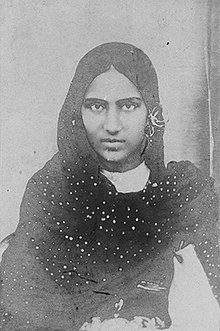Muhammadi Begum (also known as Sayyidah Muhammadi Begum; 22 May 1878 – 2 November 1908) was a Sunni Muslim scholar, Urdu writer and an advocate of women education. She co-founded the Islamic weekly magazine Tehzeeb-e-Niswan, and was its founding editor. She is known as the first woman who edited an Urdu magazine. She was the wife of Sayyid Mumtaz Ali Deobandi.
Sayyidah Muhammadi Begum | |
|---|---|
 | |
| Personal | |
| Born | 22 May 1878 |
| Died | 2 November 1908 (aged 30) Shimla, British India |
| Religion | Islam |
| Spouse | Sayyid Mumtaz Ali |
| Children | Imtiaz Ali Taj (son) |
| Denomination | Sunni Islam |
| Notable work(s) | Tehzeeb-e-Niswan |
| Relatives | Yasmeen Tahir (granddaughter) Naeem Tahir (grandson) Faran Tahir (great-grandson) Ali Tahir (great-grandson) |
Biography
editMuhammadi Begum was born on 22 May 1878 in Shahpur, Punjab.[1] She learned Urdu and she became a Hafiz as she memorized the Quran. She learned to write letters to remain in touch with her elder sister after she got married in 1886.[2]
In 1897, she became the second wife of Sayyid Mumtaz Ali Deobandi, an Islamic scholar and an alumnus of Darul Uloom Deoband.[3][4] She learned Arabic and Persian from her new husband and was privately educated in English, Hindi and mathematics.[5]
On 1 July 1898, the couple started a weekly magazine for women called Tehzeeb-e-Niswan, which is regarded as one of the pioneering works on women rights in Islam.[6] The magazine published radical ideas about divorce with enforced alimony and to end purdah and polygamy as it existed. She has been considered as India's first Muslim feminist woman[7] and the first woman who ever edited an Urdu magazine.[4] She edited Tehzeeb-e-Niswan until her death in 1908.[8]
Literary works
editMuhammadi Begum authored thirty books which included Shareef Beti, which dealt with the hazards of arranged marriages of children which often lead to enforced marriages.[5][1] Her other works include:[5]
- Aaj Kal
- Safia Begum
- Chandan Haar
- Aadab-e-Mulaqaat
- Rafeeqe Aroos
- Khaanadari
- Sughhar Beti
Death and legacy
editAged 30, Muhammadi Begum died at Shimla on 2 November 1908.[4] Her grandson Naeem Tahir compiled a biography Sayyidah Muhammadi Begum awr Unka Khandan (transl. Sayyidah Muhammadi Begum and her family).[9] Her son was Imtiaz Ali Taj who was born in 1900. She nicknamed him "Mera Taj" (My crown) and in time he would become a leading playwright and adopt her pet name for him, "Taj", as part of his own name.[10] Her daughter, Waheeda Begum, became the editor of her magazine after she died and after a few years Imtiaz Ali Taj took over.[11]
References
edit- ^ a b Sarwat Ali (10 May 2020). "Stuff legends are made of". The News International. Retrieved 22 August 2020.
- ^ Sarkar, Sumit; Sarkar, Tanika (2008). Women and Social Reform in Modern India: A Reader. p. 363. ISBN 9780253352699. Retrieved 20 August 2020.
- ^ Nayab Hasan Qasmi. "Mawlana Sayyid Mumtaz Ali Deobandi". Darul Uloom Deoband Ka Sahafati ManzarNama. Idara Tehqeeq-e-Islami, Deoband. pp. 147–151.
- ^ a b c Rauf Parekh (2 November 2015). "Muhammadi Begum and Tehzeeb-e-Niswan". Dawn. Retrieved 22 August 2020.
- ^ a b c Farrukhi, Asif (2018-09-16). "NON-FICTION: A PIONEERING WOMAN OF LETTERS". DAWN.COM. Retrieved 2022-05-04.
- ^ Moaddel, Mansoor (1998). "Religion and Women: Islamic Modernism versus Fundamentalism". Journal for the Scientific Study of Religion. 37 (1): 116. doi:10.2307/1388032. JSTOR 1388032.
- ^ Prasad, Amar Nath; Joseph, S. John Peter (2006). Indian Writing In English:Critical Rum.(part-2). Sarup & Sons. p. 255. ISBN 978-81-7625-725-1.
- ^ Tahir Kamran (8 July 2018). "Re-imagining of Muslim Women - II". thenews.com.pk. The News International. Retrieved 22 August 2020.
- ^ Asif Farrukhi (16 September 2018). "A PIONEERING WOMAN OF LETTERS". Dawn. Retrieved 22 August 2020.
- ^ "Imtiaz Ali, the Taj of Urdu drama". DAWN.COM. 2009-04-14. Retrieved 2022-05-04.
- ^ "Re-imagining of Muslim Women - II | Political Economy | thenews.com.pk". www.thenews.com.pk. Retrieved 2022-05-04.